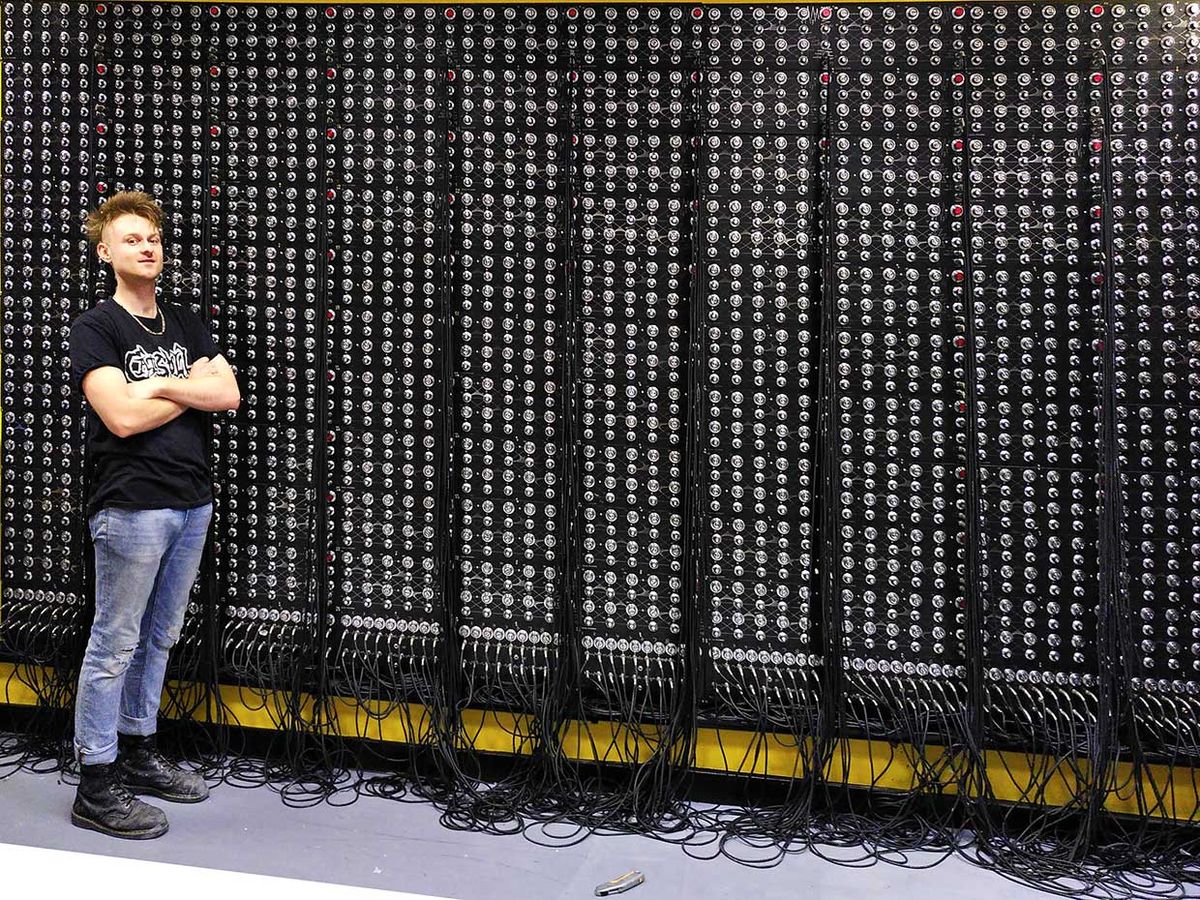When the COVID-19 lockdown came to the United Kingdom, Sam Battle became a man on a mission. Battle has created many unusual electronic musical instruments under the sobriquet of Look Mum No Computer, including an organ made out of singing Furbys and a synthesizer-bicycle hybrid. As people isolated themselves, he embarked on his most ambitious project yet: the KiloDrone.
Many of Battle’s projects involve analog synthesizers, in which a tone is generated by a circuit oscillating at audio frequencies. Multiple oscillators allow a synth to generate multiple tones simultaneously, creating richer sounds. Which raises the question: Can you ever have too many oscillators?
The KiloDrone was built to answer that question. It’s a drone synth, which means it produces sustained sounds, rather than the characteristic attack and decay of, say, a piano. Typically, a drone synth has two to eight oscillators. The KiloDrone, as its name suggests, has 1,000.
The genesis of the KiloDrone came when Battle was “messing around with some transistors, and found a circuit that was lighting up an LED when it shouldn’t be,” he explains. Battle found that he’d rediscovered the reverse-avalanche oscillator, which requires just a capacitor, resistor, and transistor. He realized he could use it as an adjustable audio oscillator, and relied on one for a Red Bull sponsorship in which he built a light-controlled synthesizer out of a drink can in 2017. After that, while he was touring in Europe, a friend joked that he should build “a big box of them.”
“Whenever something captures my imagination, it sort of stays there until it’s done,” says Battle. So he built the 100-oscillator MegaDrone. “And it didn’t seem like that was enough,” says Battle, who quickly settled on 1,000 oscillators as his next target. But “I kept on procrastinating. Then at the beginning of lockdown I was like, ‘I’ve got a few months. I may as well pick up that project.’ ”
A 1,000-oscillator analog synth isn’t exactly portable. The KiloDrone is wall mounted, 2.3 meters high, and 4 meters wide. Each oscillator is connected to an LED as well as a tuning knob and volume control. The oscillators are grouped in banks of 10, with each bank equipped with a master tuning and level control. (You can buy one of the printed circuit boards used to make the banks for US $53 and build your own smaller, standalone drone.)
Despite its size, the KiloDrone draws just 1.2 amperes at 12 volts. Consequently, it dissipates little heat, which keeps the oscillators’ frequency stable. “A lot of people were very reserved about [the KiloDrone initially],” says Battle. “They were like, ‘Oh, by the time you [adjust] the last oscillator it’ll be out of tune.’”
So what does the KiloDrone sound like? Imagine the THX effect played before movies in cinemas—like that, only more so. You can listen to it in Look Mum No Computer’s videos, but Battle says they don’t fully capture the experience of hearing it live. He hopes that, when the pandemic ends, people can come to listen to it—and play it—in a planned Museum of Everything Else dedicated to DIY devices, especially analog instruments. “I like the tangibility of analog. I hate working on computers,” says Battle. “I just can’t stand looking at screens. I like standing up and moving around and making things in a physical world.”
This article appears in the October 2020 print issue as “Let a Thousand Analog Oscillators Sing.”
Stephen Cass is the special projects editor at IEEE Spectrum. He currently helms Spectrum's Hands On column, and is also responsible for interactive projects such as the Top Programming Languages app. He has a bachelor's degree in experimental physics from Trinity College Dublin.



